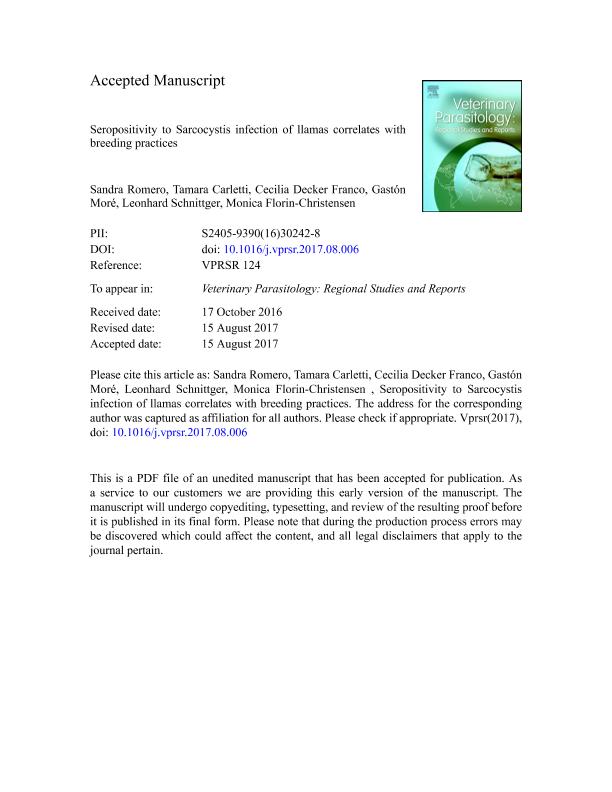Mostrar el registro sencillo del ítem
dc.contributor.author
Romero, Sandra
dc.contributor.author
Carletti, Tamara
dc.contributor.author
Decker Franco, Cecilia

dc.contributor.author
Moré, Gastón Andrés

dc.contributor.author
Schnittger, Leonhard

dc.contributor.author
Florin Christensenbd, Monica
dc.date.available
2018-04-06T17:15:49Z
dc.date.issued
2017-08
dc.identifier.citation
Romero, Sandra; Carletti, Tamara; Decker Franco, Cecilia; Moré, Gastón Andrés; Schnittger, Leonhard; et al.; Seropositivity to Sarcocystis infection of llamas correlates with breeding practices; Elsevier; Veterinary Parasitology: Regional Studies and Reports; 10; 8-2017; 65-70
dc.identifier.issn
2405-9390
dc.identifier.uri
http://hdl.handle.net/11336/41139
dc.description.abstract
Production of llama (Lama glama) meat in rural communities of the Andean regions is largely affected by Sarcocystis spp. infection. Macroscopic cysts develop in muscles as a consequence of S. aucheniae parasitism, often resulting in meat downgrade or condemnation. Llama meat production is informal in Argentina but has broad perspectives for improvement, and would significantly benefit from the development of standardized control methodologies. This work analyzes whether the presence of anti-Sarcocystis spp. antibodies in llamas is influenced by factors such as geographic region and/or herd management practices. To this aim, an indirect ELISA was set up based on a ~23 kDa soluble immunogenic protein fraction (Sa23), isolated from S. aucheniae macrocysts (Sa23- iELISA). Serum samples (n=507) were collected from llamas bred under three different conditions: (i) with no sanitation controls and in the presence of pastoral dogs by small producers of different localities of the Argentine Puna (Group I, n=237); (ii) with sanitation controls and no pastoral dogs, in fenced fields of an experimental agricultural station in the Argentine Puna (Group II, n=167); and (iii) with sanitation controls and no pastoral dogs in fenced fields of farms of the humid Pampas (Group III, n=103). Results of the Sa23- iELISA were expressed as percentages of positivity with respect to a reference Sarcocystispositive serum. Notably, the percentage of sera that fell above the cut-off (31.5% positivity) in group (i) was significantly higher (p< 0.001) than those of groups (ii) and (iii) (50% vs 23% and 26%, respectively). These results indicate that herd management practices constitute a critical risk factor for sarcocystiosis in llamas. Differences in these practices include feeding of dogs with raw Sarcocystis-infected llama meat, with the consequent maintenance of the parasite life cycle by the contamination of pastures and water with fecal-derived infective oocysts/sporocysts. Additionally, the itinerancy of llama herds in search for pastures and water sources possibly exposes animals to a higher number of infective foci. On the other hand, percentages of seropositive llamas kept under controlled conditions in the Puna or the humid Pampas were not significantly different, suggesting that climate, altitude, and/or pasture characteristics do not influence Sarcocystis-infection. Male gender and older age of llamas were found to be propensity factors for sarcocystiosis in llamas bred in La Puna under controlled conditions. Availability of diagnostic tools, as well as increased knowledge on the parasite and its epidemiology, will allow the design of control strategies for SAC sarcocystiosis
dc.format
application/pdf
dc.language.iso
eng
dc.publisher
Elsevier
dc.rights
info:eu-repo/semantics/openAccess
dc.rights.uri
https://creativecommons.org/licenses/by-nc-sa/2.5/ar/
dc.subject
Llama
dc.subject
Sarcocystiosis
dc.subject
Sarcocystis Aucheniae
dc.subject
Serology
dc.subject.classification
Otras Ciencias Biológicas

dc.subject.classification
Ciencias Biológicas

dc.subject.classification
CIENCIAS NATURALES Y EXACTAS

dc.title
Seropositivity to Sarcocystis infection of llamas correlates with breeding practices
dc.type
info:eu-repo/semantics/article
dc.type
info:ar-repo/semantics/artículo
dc.type
info:eu-repo/semantics/publishedVersion
dc.date.updated
2018-04-06T13:43:09Z
dc.journal.volume
10
dc.journal.pagination
65-70
dc.journal.pais
Países Bajos

dc.journal.ciudad
Ámsterdam
dc.description.fil
Fil: Romero, Sandra. Instituto Nacional de Tecnología Agropecuaria; Argentina
dc.description.fil
Fil: Carletti, Tamara. Instituto Nacional de Tecnología Agropecuaria. Centro de Investigación en Ciencias Veterinarias y Agronómicas; Argentina
dc.description.fil
Fil: Decker Franco, Cecilia. Consejo Nacional de Investigaciones Científicas y Técnicas; Argentina. Instituto Nacional de Tecnología Agropecuaria. Centro de Investigación en Ciencias Veterinarias y Agronómicas; Argentina
dc.description.fil
Fil: Moré, Gastón Andrés. Consejo Nacional de Investigaciones Científicas y Técnicas; Argentina. Universidad Nacional de la Plata. Facultad de Ciencias Veterinarias. Departamento de Epizootiología y Salud Pública. Laboratorio de Inmunoparasitología; Argentina
dc.description.fil
Fil: Schnittger, Leonhard. Instituto Nacional de Tecnología Agropecuaria. Centro de Investigación en Ciencias Veterinarias y Agronómicas; Argentina. Consejo Nacional de Investigaciones Científicas y Técnicas; Argentina
dc.description.fil
Fil: Florin Christensenbd, Monica. Instituto Nacional de Tecnología Agropecuaria. Centro de Investigación en Ciencias Veterinarias y Agronómicas; Argentina. Consejo Nacional de Investigaciones Científicas y Técnicas; Argentina
dc.journal.title
Veterinary Parasitology: Regional Studies and Reports
dc.relation.alternativeid
info:eu-repo/semantics/altIdentifier/doi/http://dx.doi.org/10.1016/j.vprsr.2017.08.006
dc.relation.alternativeid
info:eu-repo/semantics/altIdentifier/url/https://www.sciencedirect.com/science/article/pii/S2405939016302428
Archivos asociados
